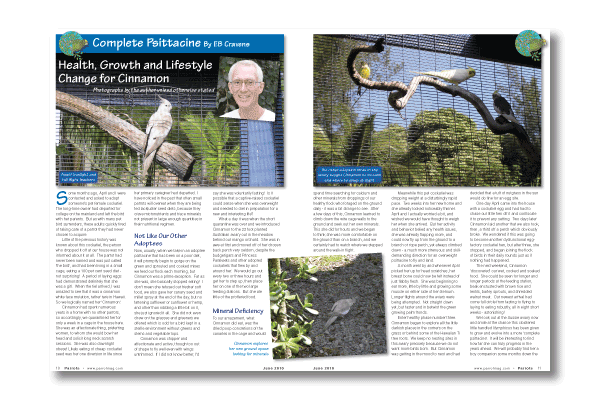
COMPLETE PSITTACINE by EB Cravens
Some months ago, April and I were contacted and asked to adopt someone’s pet female cockatiel. The long-time owner had departed for college on the mainland and left the bird with her parents. But as with many pet bird surrenders, these adults quickly tired of taking care of a parrot they had never chosen to acquire.
Little of the previous history was known about this cockatiel, the person who dropped it off at our house was not informed about it at all. The parrot had never been named and was just called 'the bird', and had been living in a small cage, eating a 100 per cent seed diet - not surprising! A period of laying eggs had demonstrated definitely that she was a girl. When the tiel arrived, I was amazed to see that it was a cinnamon white face mutation, rather rare in Hawaii. So we logically named her 'Cinnamon'.
Cinnamon had spent numerous years in a home with no other parrots, so accordingly, we quarantined her for only a week in a cage in the house here. She was an affectionate thing, preferring women, to whom she would bow her head and solicit long neck scratch sessions. She was also downright obese! Likely eating of cheap cockatiel seed was her one diversion in life since her primary caregiver had departed. I have noticed in the past that often small parrots will overeat when they are being fed lackluster seed diets, because they crave micronutrients and trace minerals not present in large enough quantities in their nutritional regimen.
Read more in the magazine…
Buy a copy now!
BACK
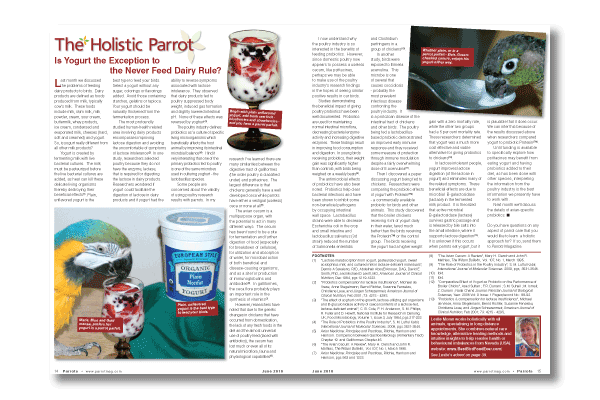
THE HOLISTIC PARROT by Leslie Moran
Last month we discussed the problems of feeding dairy products to birds. Dairy products are defined as foods produced from milk, typically cow’s milk. These foods include milk, skim milk, milk powder, cream, sour cream, buttermilk, whey products, ice cream, condensed and evaporated milk, cheeses (hard, soft and creamed) and yogurt. So, is yogurt really different from all other milk products?
Yogurt is created by fermenting milk with live bacterial cultures. The milk must be pasteurized before the live bacterial cultures are added, as heat can kill these delicate living organisms thereby destroying their beneficial effects. Plain, unflavored yogurt is the best type to feed your birds. Select a yogurt without any sugar, colorings or flavorings added. Avoid those containing starches, gelatins or tapioca. Your yogurt should be naturally thickened from the fermentation process.
The most profoundly studied human-health related area involving dairy products encompasses improving lactose digestion and avoiding the uncomfortable of symptoms of lactose intolerance. In one study, researchers selected poultry because they do not have the enzyme, lactase, that is required for digesting the lactose in dairy products. Researchers wondered if yogurt could facilitate the digestion of lactose in dairy products and if yogurt had the ability to reverse symptoms associated with lactose intolerance. They observed that dairy products fed to poultry suppressed body weight, induced gas formation and slightly lowered intestinal pH. None of these effects was reversed by yoghurt.
Read more in the magazine…
Buy a copy now!
BACK
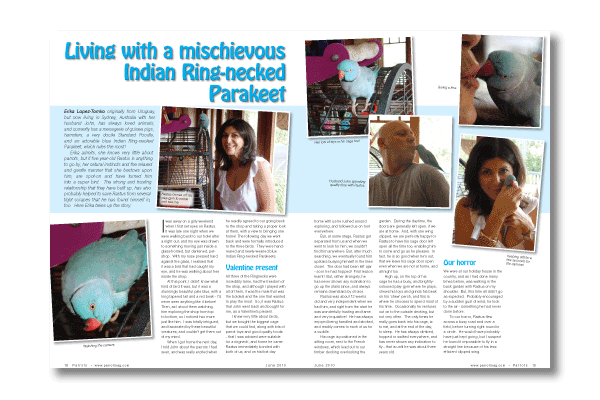 Erika Lopez-Tomko originally from Uruguay, but now living in Sydney, Australia with her husband John, has always loved animals, and currently has a menagerie of guinea pigs, hamsters, a very docile Standard Poodle, and an adorable blue Indian Ring-necked Parakeet, which rules the roost!
Erika Lopez-Tomko originally from Uruguay, but now living in Sydney, Australia with her husband John, has always loved animals, and currently has a menagerie of guinea pigs, hamsters, a very docile Standard Poodle, and an adorable blue Indian Ring-necked Parakeet, which rules the roost!
Erika admits, she knows very little about parrots, but if five year-old Rastus is anything to go by, her natural instincts and the relaxed and gentle manner that she bestows upon him, are spot-on and have turned him into a super bird. The strong and trusting relationship that they have built up, has also probably helped to save Rastus from several tight scrapes that he has found himself in, too. Here Erika takes up the story:
I was away on a girly weekend when I first set eyes on Rastus. It was late one night when we were walking back to our hotel after a night out, and my eye was drawn to something moving just inside a glass-fronted, but darkened, pet-shop. With my nose pressed hard against the glass, I realised that it was a bird that had caught my eye, and he was walking about free inside the shop.
At this point, I didn’t know what kind of bird it was, but it was a stunningly beautiful pale blue, with a long tapered tail and a red beak - I’d never seen anything like it before! Then, as I stood there watching him exploring the shop from top to bottom, so I noticed two more just like him. I was totally intrigued, and fascinated by these beautiful creatures, and couldn’t get them out of my mind.
Read more in the magazine…
Buy a copy now!
BACK
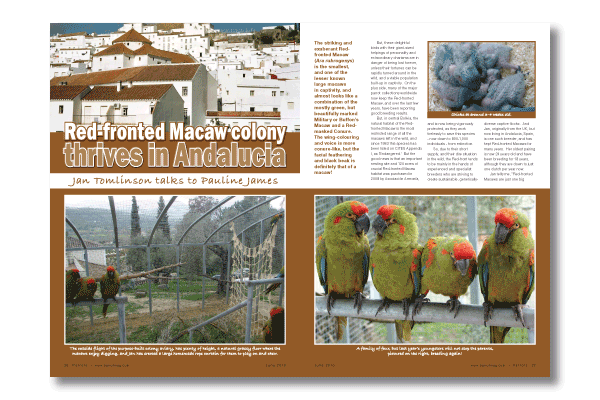
Jan Tomlinson talks to Pauline James
The striking and exuberant Red-fronted Macaw (Ara rubrogenys) is the smallest, and one of the lesser known large macaws in captivity, and almost looks like a combination of the mostly green, but beautifully marked Military or Buffon’s Macaw and a Red-masked Conure. The wing-colouring and voice is more conure-like, but the facial feathering and black beak is definitely that of a macaw!
But, these delightful birds with their giant-sized helpings of personality and extraordinary charisma are in danger of being lost forever, unless their fortunes can be rapidly turned around in the wild, and a viable population built-up in captivity. On the plus side, many of the major parrot collections worldwide now keep the Red-fronted Macaw, and over the last few years, have been reporting good breeding results.
But, in central Bolivia, the natural habitat of the Red-fronted Macaw is the most restricted range of all the macaws left in the wild, and since 1983 this species has been listed on CITES Appendix I, as ‘Endangered.’ But the good news is that an important nesting site and 124 acres of crucial Red-fronted Macaw habitat was purchased in 2008 by Asociación Armonía, and is now being vigorously protected, as they work tirelessly to save this species - now down to 800-1,000 individuals - from extinction.
So, due to their short supply, and their dire situation in the wild, the Red-front tends to be mainly in the hands of experienced and specialist breeders who are striving to create sustainable, genetically-diverse captive flocks. And Jan, originally from the UK, but now living in Andalucia, Spain, is one such breeder, and has kept Red-fronted Macaws for many years. Her oldest pairing is now 24 years old and have been breeding for 18 years, although they are down to just one clutch per year now.
Read more in the magazine…
Buy a copy now!
BACK
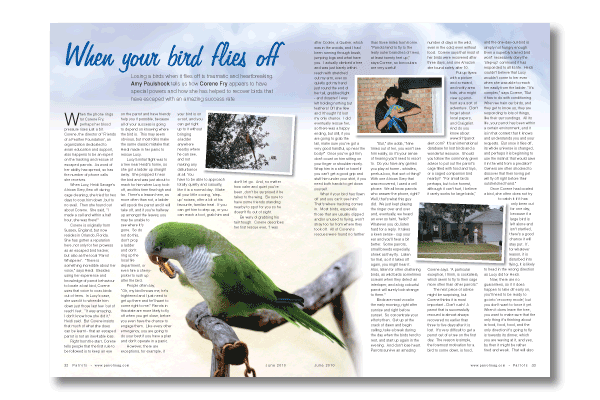 Losing a birds when it flies off is traumatic and heartbreaking. Amy Paulshock tells us how Corene Fry appears to have special powers and how she has helped to recover birds that have escaped with an amazing success rate.
Losing a birds when it flies off is traumatic and heartbreaking. Amy Paulshock tells us how Corene Fry appears to have special powers and how she has helped to recover birds that have escaped with an amazing success rate.
When the phone rings for Corene Fry, perhaps her blood pressure rises just a bit. Corene, the director of ‘Friends of a Feather Foundation’, an organization dedicated to avian education and support, also happens to be an expert on the tracking and rescue of escaped parrots. As word of her ability has spread, so has the number of phone calls she receives.
When Lucy, Heidi Savage’s African Grey, flew off during cage cleaning, she tried for two days to coax him down, but to no avail. Then she found out about Corene. She said, “I made a call and within a half hour, she was there!”
Corene is originally from Sussex, England, but now resides in Orlando, Florida. She has gotten a reputation here, not only for her prowess as an escaped bird tracker, but also as the local ‘Parrot Whisperer’. “There is something incredible about her voice,” says Heidi. Besides using her experience and knowledge of parrot behaviour to locate a lost bird, Corene uses that voice to coax birds out of trees. In Lucy’s case, she used it to wheedle him down just those last few ‘out of reach’ feet. “It was amazing, I don’t know how she did it,” Heidi said. But Corene insists that much of what she does can be learnt - that an escaped parrot is not an inevitable loss.
Read more in the magazine…
Buy a copy now!
BACK
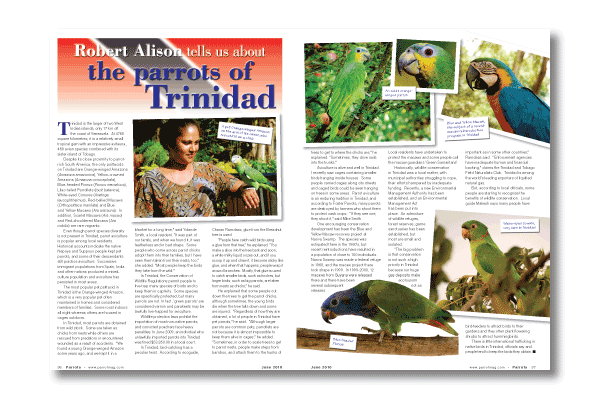 Trinidad is the larger of two West Indies islands, only 17 km off the coast of Venezuela. At 4768 square kilometres, it is a relatively small tropical gem with an impressive avifauna, 468 avian species combined with its sister island of Tobago.
Trinidad is the larger of two West Indies islands, only 17 km off the coast of Venezuela. At 4768 square kilometres, it is a relatively small tropical gem with an impressive avifauna, 468 avian species combined with its sister island of Tobago.
Despite its close proximity to parrot-rich South America, the only psittacids on Trinidad are Orange-winged Amazons (Amazona amazonica), Yellow-crowned Amazons (Amazona ocrocephala), Blue-headed Pionus (Pionus menstruus), Lilac-tailed Parrotlets (touit batavica), White-eyed Conures (Aratinga leucophthalmus), Red-bellied Macaws (Orthopsittaca manilata) and Blue and Yellow Macaws (Ara ararauna). In addition, Scarlet Macaws (Ara macao) and Red-shouldered Macaws (Ara nobilis) are rare vagrants.
Even though parrot species diversity is not present in Trinidad, parrot aviculture is popular among local residents. Historical accounts indicate the native Nepoya and Suppoyo people kept pet parrots, and some of their descendants still practice aviculture. Successive immigrant populations from Spain, India and other nations produced a mixed-culture population and aviculture has persisted in most areas.
Read more in the magazine…
Buy a copy now!
BACK



 Erika Lopez-Tomko originally from Uruguay, but now living in Sydney, Australia with her husband John, has always loved animals, and currently has a menagerie of guinea pigs, hamsters, a very docile Standard Poodle, and an adorable blue Indian Ring-necked Parakeet, which rules the roost!
Erika Lopez-Tomko originally from Uruguay, but now living in Sydney, Australia with her husband John, has always loved animals, and currently has a menagerie of guinea pigs, hamsters, a very docile Standard Poodle, and an adorable blue Indian Ring-necked Parakeet, which rules the roost! 
 Losing a birds when it flies off is traumatic and heartbreaking. Amy Paulshock tells us how Corene Fry appears to have special powers and how she has helped to recover birds that have escaped with an amazing success rate.
Losing a birds when it flies off is traumatic and heartbreaking. Amy Paulshock tells us how Corene Fry appears to have special powers and how she has helped to recover birds that have escaped with an amazing success rate.  Trinidad is the larger of two West Indies islands, only 17 km off the coast of Venezuela. At 4768 square kilometres, it is a relatively small tropical gem with an impressive avifauna, 468 avian species combined with its sister island of Tobago.
Trinidad is the larger of two West Indies islands, only 17 km off the coast of Venezuela. At 4768 square kilometres, it is a relatively small tropical gem with an impressive avifauna, 468 avian species combined with its sister island of Tobago.